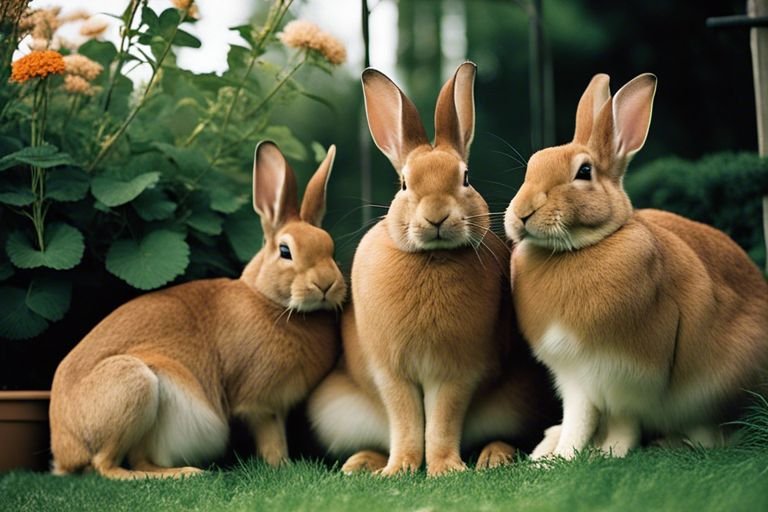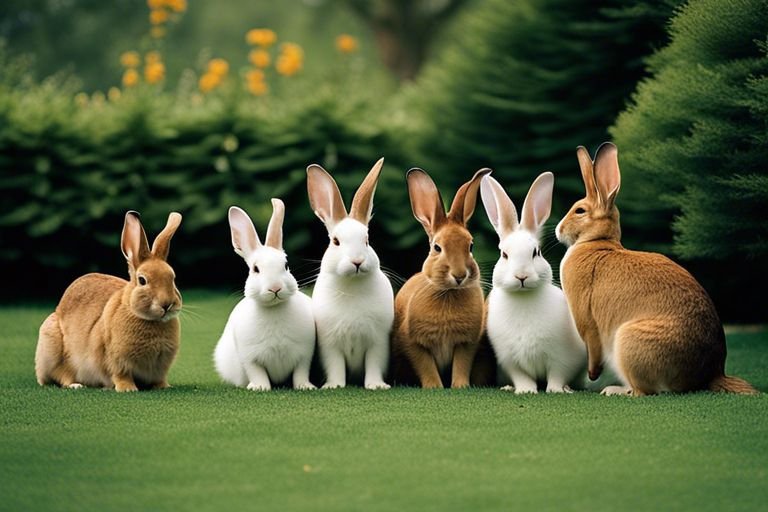Greetings, fellow rabbit enthusiasts! Have you ever wondered how Flemish Giants communicate with each other? These majestic rabbits, known for their gentle nature and enormous size, have a sophisticated system of nonverbal and verbal communication that is fascinating to explore. In this blog post, we will delve into the various ways in which Flemish Giants express themselves and interact with one another, shedding light on their intriguing social dynamics and communication methods.
Key Takeaways:
- Thumping: Flemish Giants use thumping as a form of communication to signify danger or call for attention.
- Body language: They express themselves through their body language, such as ear positioning and tail movements.
- Grunting: Flemish Giants also use grunting sounds to communicate with each other, especially during mating rituals or aggression.
- Vocalizations: They make various vocalizations, including squeaks, to convey their emotions and needs to other rabbits.
- Scents: Flemish Giants rely on scent marking to communicate territories and information to other rabbits through their strong sense of smell.
Flemish Giants’ Communication Habits
One of the most fascinating aspects of Flemish Giant rabbits is their communication habits. These gentle giants have a variety of ways to communicate with each other and with their human caretakers. If you want to understand your Flemish Giant better, it’s important to learn about their communication style. You can find a comprehensive guide to Flemish Giant rabbit communication habits in this Flemish Giant Rabbit guide.
Body Language and Postures
When it comes to communication, Flemish Giants rely heavily on body language and postures. They use a variety of ear, body, and tail positions to convey their emotions and intentions. For example, a relaxed Flemish Giant will have ears and tail in a natural position, while a scared rabbit will flatten their ears against their body. It’s important to pay attention to these subtle cues to understand how your rabbit is feeling. Pay attention to signs of stress or fear such as thumping hind legs, and positive signals such as gentle nose nudges or grooming behavior to better understand your Flemish Giant’s communication style.
Vocalizations and Sounds
In addition to body language, Flemish Giants also use vocalizations and sounds to communicate. While they are generally quiet animals, they can make soft grunting or honking sounds to express contentment or displeasure. They may also let out a loud scream if they are in distress. Pay attention to these vocal cues to better understand what your Flemish Giant is trying to tell you. Your ability to recognize and interpret these sounds will strengthen your bond with your rabbit.
By understanding the communication habits of Flemish Giants, you can build a strong relationship with your rabbit and provide the best care possible. Each interaction with your rabbit is an opportunity to learn more about their unique communication style. This knowledge will help you address their needs and ensure their well-being. Keep observing your rabbit’s behavior and pay attention to their cues. This will allow you to develop a deep understanding of their communication habits and strengthen the bond between you and your Flemish Giant.
Socialization and Interaction
The socialization and interaction of Flemish Giants are an essential aspect of their communication. These gentle giants are social animals that thrive on interaction with others, whether it be humans, other rabbits, or even other pets in the household. Understanding their social behaviors is crucial for creating a harmonious environment for your Flemish Giant.
Socialization with Humans and Pets
When it comes to socializing with humans and other pets, Flemish Giants are known for their friendly and affectionate nature. They enjoy spending time with their human companions, often seeking out attention and physical interaction. It’s important to provide them with plenty of opportunities to interact with you and other household pets, as this helps to strengthen their bond with you and ensures they feel secure and loved.
Group Dynamics Among Flemish Giants
Group dynamics among Flemish Giants can be quite fascinating. These rabbits are known for their gentle nature, and they generally get along well with other rabbits, especially if they are introduced at a young age. However, it’s essential to be mindful of their interactions to prevent any potential conflicts or dominance issues. Observing their body language and ensuring they have enough space and resources can help to maintain a peaceful and harmonious group dynamic.
By understanding the socialization and interaction behaviors of Flemish Giants, you can provide them with the best possible care and companionship. It’s essential to ensure they have plenty of opportunities for social interaction with you and other pets, as well as monitoring their interactions with other rabbits to maintain a positive and safe environment for all. Paying attention to their body language and behavior can help you better understand their communication and ensure a happy and fulfilling life for your Flemish Giant.
Health and Care Influencing Communication
Your Flemish Giant’s health and care can have a significant impact on their ability to communicate with each other. From the effects of neutering on behavior to the role of diet and nutrition in expressing feelings, it’s important to consider these factors in order to understand how your rabbits communicate.
Impact of Neutering on Behavior
Neutering your Flemish Giant can have a profound impact on their behavior and communication. Neutering can reduce aggressive behavior and territorial marking in both male and female rabbits, resulting in a more harmonious communication with other rabbits. If you notice any behavioral changes in your rabbits after neutering, it’s important to give them time to adjust and communicate with them to ensure they feel safe and secure.
The Role of Diet and Nutrition in Expressing Feelings
The diet and nutrition of your Flemish Giant can also play a significant role in their ability to express their feelings and communicate with other rabbits. Providing a balanced diet with plenty of hay, vegetables, and a limited amount of pellets can contribute to their overall health and well-being, which in turn can positively influence their communication with other rabbits. Additionally, ensuring proper hydration and incorporating enriching foods into their diet can help facilitate positive interactions and emotional expression among your rabbits.
Training and Enrichment
Lastly, it’s important to consider how to effectively train and provide enrichment for your Flemish Giant. By using the right methods and offering a stimulating environment, you can help your rabbit develop good communication skills and overall well-being.
Effective Training Methods for Flemish Giants
When it comes to training your Flemish Giant, consistency is key. Whether you’re teaching them to use a litter box or to come when called, using positive reinforcement such as treats and praise can be very effective. Additionally, understanding their body language and vocalizations can help you communicate your expectations clearly and build a strong bond with your rabbit. It’s crucial to avoid using punishment-based training methods, as this can lead to fear and distrust.
Environmental Enrichment and Mental Stimulation
Providing mental stimulation and enrichment for your Flemish Giant is essential for their overall well-being. This can include offering a variety of toys, tunnels, and hiding spots in their living space, as well as allowing them time to roam and explore in a safe area outside of their enclosure. You can also consider introducing new experiences, such as different textures and smells, to keep them engaged and stimulated. Failure to provide adequate mental stimulation can lead to boredom and potentially destructive behaviors.
By understanding the most effective training methods and providing plenty of mental stimulation, you can help your Flemish Giant communicate more effectively and lead a happier, healthier life. Whether it’s reinforcing positive behaviors or offering new enrichment opportunities, you have the power to make a positive impact on your rabbit’s life. How do you plan to incorporate these training and enrichment strategies into your Flemish Giant’s routine?

Conclusion
With these considerations, you can see that Flemish Giants communicate with each other through a variety of vocalizations, body language, and olfactory signals. Their complex social behaviors and interactions play a crucial role in their communication and overall well-being. By understanding and observing these communication methods, you can better care for and interact with your own Flemish Giant rabbit, enhancing their quality of life and strengthening your bond with them.
FAQ
Q: How do Flemish Giants communicate with each other?
A: Flemish Giants primarily communicate with each other through body language and vocalizations. They use various ear, tail, and body movements to convey their feelings and intentions to one another. Additionally, they may emit soft grunts, thumps, or low growls to express their emotions. These methods of communication help them establish social hierarchies, express territorial boundaries, and communicate with potential mates.
Q: What are some common body language signals used by Flemish Giants to communicate?
A: Flemish Giants use a range of body language signals to communicate with each other. Some common signals include thumping their hind legs to indicate danger or territorial boundaries, laying their ears flat against their body to express fear or aggression, and grooming each other to reinforce social bonds. They may also use aggressive postures such as raising their fur or standing upright to establish dominance or defend their territory.
Q: Can Flemish Giants communicate with other rabbit breeds or animals outside their species?
A: While Flemish Giants primarily communicate with members of their own species, they can also use their body language and vocalizations to interact with other rabbit breeds and animals. They may exhibit similar communication signals such as thumping, ear movements, and grooming to establish social hierarchies and maintain relationships with other animals. However, it’s important to monitor their interactions with other species to ensure the safety and well-being of all animals involved.
